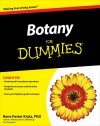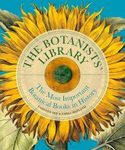![Botany for Dummies Botany for Dummies]()
Click to have a closer look
About this book
Contents
Biography
Related titles
About this book
Botany For Dummies gives you a thorough, easy-to-follow overview of the fundamentals of botany, helping you to improve your grades, supplement your learning, or review before a test. It covers evolution by natural selection, offers plain-English explanations of the structure and function of plants, and includes plant identification and botanical phenomena. Tracking a typical course in botany, this hands-on, friendly guide is your ticket to passing this required course for your major in biology, microbiology, zoology, or elementary education.
Contents
Introduction Part I: Plant Basics Chapter 1: Exploring Botany Chapter 2: Peering at Plant Cells Chapter 3: Identifying Plant Tissues Chapter 4: Vegetative Structures: Stems, Roots, and Leaves Chapter 5: Reproductive Structures: Spores, Seeds, Cones, Flowers, and Fruits Part II: The Living Plant: Plant Physiology Chapter 6: Metabolism: How Living Things Get Energy and Matter Chapter 7: Photosynthesis: Making Sugar from Scratch Chapter 8: Cellular Respiration: Making Your Cake and Eating It, Too Chapter 9: Moving Materials Through Plants Chapter 10: Regulating Plant Growth and Development Part III: Making More Plants: Plant Reproduction and Genetics Chapter 11: Greening the Earth: Plant Reproduction Chapter 12: Passing Plant Characteristics to the Next Generation Part IV: The Wide, Wonderful World of Plants: Plant Biodiversity Chapter 13: Changing with the Times: Evolution and Adaptation Chapter 14: The Tree of Life: Showing the Relationships Between Living Things Chapter 15: Examining the Forest Floor: Bryophytes and Seedless Vascular Plants Chapter 16: Their Seeds Are Naked: Gymnosperms Chapter 17: Say It with Flowers: Angiosperms Part V: Plants and People Chapter 18: Making Connections with Plant Ecology Chapter 19: Altering Plants by Using Biotechnology Chapter 20: Thriving on Plants in Everyday Life Part VI: The Part of Tens Chapter 21: Ten Weirdest Plants Chapter 22: Ten Tips for Improving Your Grade in Botany Index
Customer Reviews
Biography
Rene Fester Kratz, PhD is a Biology instructor at Everett Community College. As a member of the North Cascades and Olympic Science Partnership, she worked to develop science curricula that are in alignment with research on human learning.













































